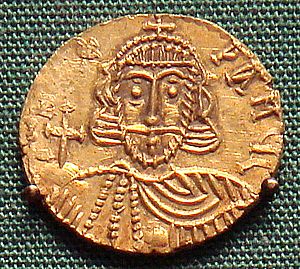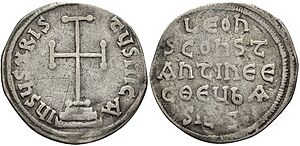Leo III the Isaurian facts for kids
Quick facts for kids Leo III the Isaurian |
|
|---|---|
| Emperor of the Romans | |

Leo III (left) and his son Constantine V
|
|
| Emperor of the Byzantine Empire | |
| Reign | 25 March 717 – 18 June 741 |
| Predecessor | Theodosios III |
| Successor | Constantine V |
| Born | c. 685 Germanikeia, Byzantine Empire |
| Died | 18 June 741 (aged 55 or 56) |
| Spouse | Maria |
| Issue | Constantine V Anna Irene Kosmo |
| Dynasty | Isaurian dynasty |
Leo III the Isaurian, also known as the Syrian, was a powerful Byzantine Emperor. He ruled from 717 until his death in 741. Leo III started the Isaurian dynasty, a family line of emperors.
He brought an end to a very unstable time in the Byzantine Empire called the "Twenty Years' Anarchy." During this period (695-717), many emperors quickly came and went. Leo III also successfully defended the Empire from attacks by the Umayyads. He is also famous for starting a religious movement called Iconoclasm, which meant forbidding the use of religious images or "icons."
Contents
Life of Leo III



Early Life and Rise to Power
Leo's original name was Konon. He was born around 685 in Germanikeia, a city in what is now Turkey. Some stories say his family moved to Thrace. There, he joined the army of Emperor Justinian II in 705.
Konon became a skilled soldier and diplomat. He was sent on important missions, like making alliances against the Umayyad Caliphate. Later, Emperor Anastasius II made Konon the commander of a major army region called the Anatolic theme.
When a new emperor, Theodosius III, took the throne, Konon teamed up with another commander, Artabasdus. They planned to overthrow Theodosius III. As part of their agreement, Artabasdus got engaged to Leo's daughter, Anna.
Defending Constantinople
Leo entered the capital city, Constantinople, on March 25, 717. He forced Theodosius III to step down and became Emperor Leo III. Right away, he faced a huge challenge: the Second Arab siege of Constantinople.
In August 717, a massive Arab army and navy arrived. They were sent by the Umayyad Caliphate. The Byzantines had prepared well for three years under the previous emperor. Leo III's strong leadership and the city's tough walls helped them resist.
A key weapon for the Byzantines was Greek fire, a special liquid that burned on water. The Arabs also suffered from a harsh winter and a lack of food. Bulgarian allies arrived to help the Byzantines, attacking the Arab forces. After 12 months, the Arabs had to give up the siege in August 718. This victory saved the Byzantine Empire from being conquered.
Making the Empire Stronger
After saving the Empire, Leo III worked to make its government and army stronger. Everything had become very disorganized during the "Twenty Years' Anarchy."
He stopped rebellions in places like Sicily. To protect the Empire's borders, he invited Slavic people to settle in empty areas. He also made the army more effective. When the Umayyad Caliphate attacked again in 726 and 739, Leo's forces won important battles, especially at Akroinon in 740. He also made alliances with groups like the Khazars and Georgians.
Leo III also made new laws. He created a new set of laws called the Ecloga (meaning "Selection") in 726. These laws aimed to make things fairer, for example, by helping serfs (people tied to the land) become free tenants. He also reorganized some of the Empire's administrative regions, called "themes."
The Iconoclasm Debate
Leo's most famous changes were about religion, especially iconoclasm. This word means "icon-breaking." Icons are religious images or paintings.
In 722, he tried to make all Jews and Montanists (another religious group) in the Empire get baptized. Then, from 726 to 729, he issued orders against the worship of icons. This was a big change because Christians had used icons for centuries. Some think he was influenced by Islamic ideas or wanted to please non-Christians. Many nobles and officials supported him.
However, most religious leaders and monks strongly opposed these new rules. In the western parts of the Empire, people refused to obey. A revolt broke out in Greece in 727, but Leo's navy crushed it.
In 730, the head of the church in Constantinople, Patriarch Germanos I, resigned because he wouldn't agree with the iconoclast rules. Leo replaced him with Anastasios, who supported the Emperor.
In Italy, the Popes, Gregory II and Gregory III, disagreed with Leo about icons. They held meetings in Rome to condemn the iconoclasts. In return, Leo took control of Southern Italy and Illyricum away from the Pope and gave it to the Patriarch of Constantinople. There was also fighting in Ravenna, Italy, and this area eventually broke away from the Empire.
Some historians believe that Muslim leaders, like Caliph Yazid II, also issued similar orders against Christian images around the same time.
Death
Emperor Leo III died in June 741 from an illness.
Family
Leo III and his wife Maria had four known children:
- Anna, who married Artabasdus.
- Constantine V, who became the next emperor.
- Irene
- Kosmo
See also
 In Spanish: León III (emperador) para niños
In Spanish: León III (emperador) para niños

